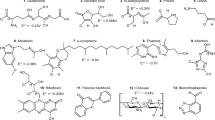Abstract
The effects of four monoterpenes—camphor, eucaliptol, limonene, and α-pinene—on the oxidative metabolism of mitochondria isolated from maize root (Zea mays), on maize seed germination, and on primary root growth were investigated. The effects of individual monoterpenes on respiration were variable. α-Pinene concentrations of 0.05–1.0 mM stimulated respiration with a mixture of substrates composed of NADH, L-malate, succinate, and L-glutamate, and in the absence of exogenously added ADP (basal respiration). However, at concentrations higher than 1.0 mM, α-pinene inhibited respiration both in the absence (basal respiration) and presence of ADP (coupled respiration). Limonene at 0.1 mM or above stimulated basal respiration and inhibited in parallel the coupled respiration. Similar effects were promoted by eucaliptol, but at a higher concentration range (1.0 mM or above). Camphor was less active. At 10 mM concentration, it caused stimulation of basal respiration but did not affect coupled respiration. In the concentration range 0.1–10.0 mM, limonene was inactive on seed germination and primary root growth. Camphor and eucaliptol did not inhibit germination but reduced fresh and/or dry weight of roots at 5.0 mM and above. α-Pinene inhibited both seed germination and fresh weight of primary roots at 10.0 mM concentration. The results indicate that intact seeds and primary roots are less sensitive than isolated mitochondria. The relatively more lipophilic monoterpenes α-pinene and limonene had less activity than the more water-soluble oxygenated monoterpenes camphor and eucaliptol in inhibiting seed germination and/or primary root growth, despite the fact that they had a higher activity on the oxidative metabolism of isolated mitochondria. The findings suggest that the solubility of monoterpenes may be the major factor implicated in these differences.
Similar content being viewed by others
REFERENCES
AlSaadawi, I. S., Arif, M. B., and AlRubeaa, A. J. 1985. Allelopathic effects of Citrus aurantium L. II. Isolation, characterization, and biological activities of phytotoxins. J. Chem. Ecol. 11:1527–1534.
Bramley, M. 1997. Isoprenoid metabolism, pp. 417-437, in P. M. Dey and J. B. Harborne (eds.), Plant Biochemistry. Academic Press, San Diego.
Chance, B., and Williams, G. R. 1955. A simple and rapid assay of oxidative phosphorylation. Nature 175:1120–1121.
Day, D. A., Moore, A. L., Dry, I. B., Wiskich, J. T., and Azcon-Bieto, J. 1988. Regulation of nonphosphorylating electron transport pathways in soybean cotyledon mitochondria and its implications for fat metabolism. Plant Physiol. 86:1199–1204.
Fischer, N. H. 1991. Plant terpenoids as allelopathic agents, pp. 377-399, in J. B. Harbone and F. A. Tomes-Barberan (eds.), Ecological Chemistry and Biochemistry of Plant Terpenoids. Claredon Press, Oxford, U.K.
Fischer, N. H., Williamson, G. B., Weidenhamer, J. D., and Richardson, D. R. 1994. In search of allelopathy in the Florida scrub: The role of terpenoids. J. Chem. Ecol. 20:1355–1379.
Hopfer, U., Lehninger, A. L., and Thompson, T. E. 1968. Protonic conductance across phospholipid bilayer membranes induced by uncouplers of oxidative phophorylation. Proc. Natl. Acad. Sci. U.S.A. 59:484–490.
Jackson, C., Dench, J. E., Hall, D. O., and Moore, A. L. 1979. Separation of mitochondria from contaminating subcellular structures utilizing silica sol gradient centrifugation. Plant Physiol. 64:150–153.
Kohli, R. K., and Singh, D. 1991. Allelopathic impact of volatile components from Eucalyptus on crop plants. Biol. Plant. 33:475–483.
Kramer, P. J. 1983. Water Relations of Plants. Academic Press, Orlando, Florida.
Langenheim, J. H. 1994. Higher plant terpenoids: A phytocentric overview of their ecological roles. J. Chem. Ecol. 20:1223–1280.
Lowry, O., Rosebrough, N. J., Farr, A. L., and Randall, R. J. 1951. Protein measurements with the Folin phenol reagent. J. Biol. Chem. 193:265–275.
Muller, W. H., and Muller, C. H. 1964. Volatile growth inhibitors produced by Salvia species. Bull. Torrey Bot. Club 91:327–330.
PeÑuelas, J., Ribas-Carbo, M., and Giles, L. 1996. Effects of allelochemicals on plant respiration and oxygen isotope fractionation by the alternative oxidase. J. Chem. Ecol. 22:801–805.
Souto, X. C., Gonzalez, L., and Reigosa, M. J. 1995. Allelopathy in forest environment in Galicia, NW Spain. Allelopathy J. 2:67–78.
Swain, T. 1977. Secondary compounds as protective agents. Annu. Rev. Plant Physiol. 28:479–501.
Terada, H. 1981. The interaction of highly active uncouplers with mitochondria. Biochem. Biophys. Acta 639:225–242.
Author information
Authors and Affiliations
Rights and permissions
About this article
Cite this article
Abrahim, D., Braguini, W.L., Kelmer-Bracht, A.M. et al. Effects of Four Monoterpenes on Germination, Primary Root Growth, and Mitochondrial Respiration of Maize. J Chem Ecol 26, 611–624 (2000). https://doi.org/10.1023/A:1005467903297
Issue Date:
DOI: https://doi.org/10.1023/A:1005467903297




